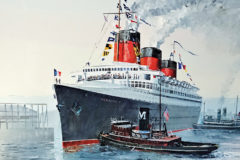Fordson E1A Series at 70!
Posted by Chris Graham on 5th July 2021
Jane Brooks takes a nostalgic look back at the Fordson E1A Series tractors in this, the 70th anniversary year of its launch.
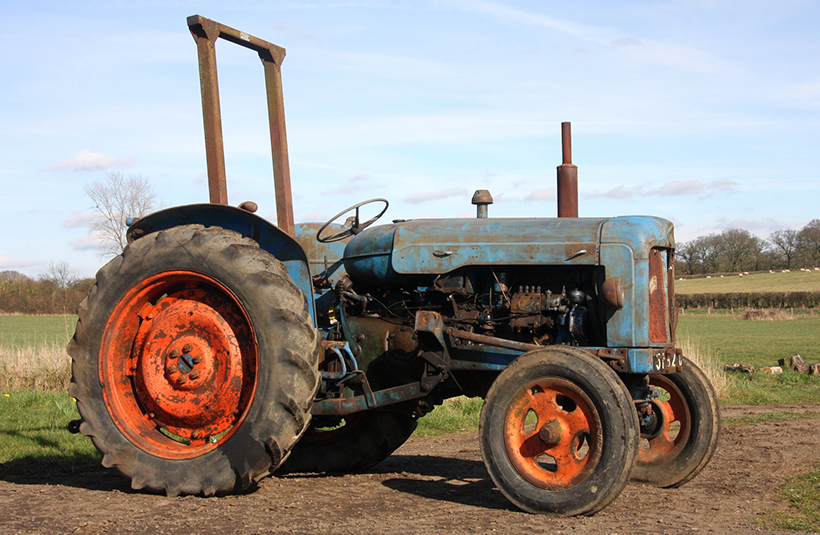
Fordson E1A Series: The New Major with the diesel engine – often referred to as the ‘Diesel Major’ – was replaced by the Power Major in July 1958.
Launched at the Smithfield Show in December, 1951, as a replacement for the popular E27N, the first of Fordson’s E1A series tractors was the New Fordson Major.
In its Smithfield Show report, Commercial Motor magazine noted that it was the first time that a Fordson tractor had been offered with an oil (diesel) engine of Ford design and construction, together with petrol and vaporising-oil engines.
The report went on to comment: The use of common major components, such as crankcase and cylinder block, crankshaft and other units, for all three engines not only cheapens production, but offers decided advantages to the operator.

First launched at the 1951 Smithfield Show, the E1A New Fordson Major was widely advertised in 1952.
Evidence of this is to be found in the price of the oil-engine version, which is £109 5s. less than that of the old model. As the mountings of the three engines are identical, no installation problems arise in changing from one type of unit to another.
Common components
Equipped with the new E1A overhead-valve, four-cylinder engine designed by Laurie Martland, the engine shared many components, including the same, 3.6-litre block. However, compression ratings differed according to the fuel. Running on petrol, TVO or diesel, the new tractor was in the 40hp range.
At the time of the launch, Commercial Motor quoted Ford’s engine output figures, stating that: The oil (diesel) engine develops just under 42hp at 1,700rpm, and gives its maximum torque of 140lb-ft. at 1,150rpm; at 1,700rpm, the petrol engine develops 40hp, and the vaporising oil engine of the same capacity as the oil engine gives just under 40hp, at 1,700rpm. The maximum ‘drawbar hp of the oil engine at 1,600rpm is 29.75, of the petrol unit, 29 and, of the vaporising oil engine, 28.25.
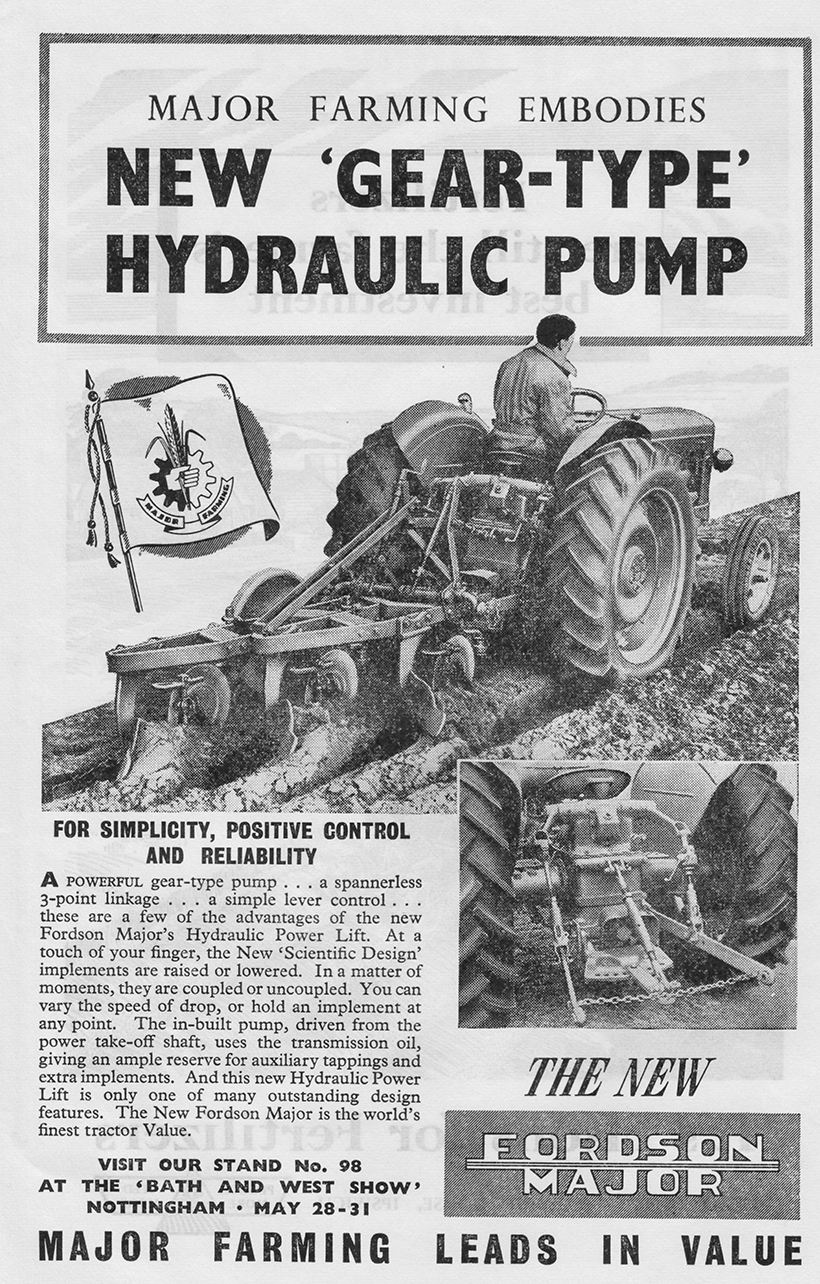
Hydraulic power lift was also advertised in 1956, which was around the time that Harry Ferguson’s patents were expiring, so most manufacturers were offering various types of three-point linkage.
The New Major had six forward and two reverse gears, with an 11in diameter dry clutch based on the old E27N, although there were some modifications to the rear transmission, with a redesigned Hydraulic Power lift and drawbar. Although most tractors had hydraulics and a PTO, some were available without.
The front axle and radiator were supported on a sub-frame, which was a complete departure from previous designs. There was also a new colour scheme of Fordson New Major Blue combined with Fordson New Major Orange wheels.
Serial number position
Early serial numbers of the E1A (up until No.1380938) were to be found on the left-hand side of the flywheel housing, near the starter motor. However, this marking was then relocated to the front, right-hand side of the engine block.

The 1955 version of the E1A diesel engine was to undergo several changes during its lifetime, culminating in a power unit producing 55hp.
Demand for vaporising oil-powered engines drastically reduced, so this fuel option was phased out altogether with the launch of the MkII engine, in April, 1957 (from serial number 1425097). Except for some carburettor and inlet and exhaust manifold changes, the petrol engine remained pretty much unchanged, and continued being used until 1964.
However, the diesel engine went through several changes and modifications, which included the introduction of alloy cylinder head bolts in September 1953 (applied to the petrol engine, as well). In September 1954, a narrow fan belt was introduced, which led to changes in the crankshaft, generator and water pump pulleys.
The Livedrive-Live PTO was introduced in 1957, from engine number 1435545. New Fordson Majors remained in production until August 1958.
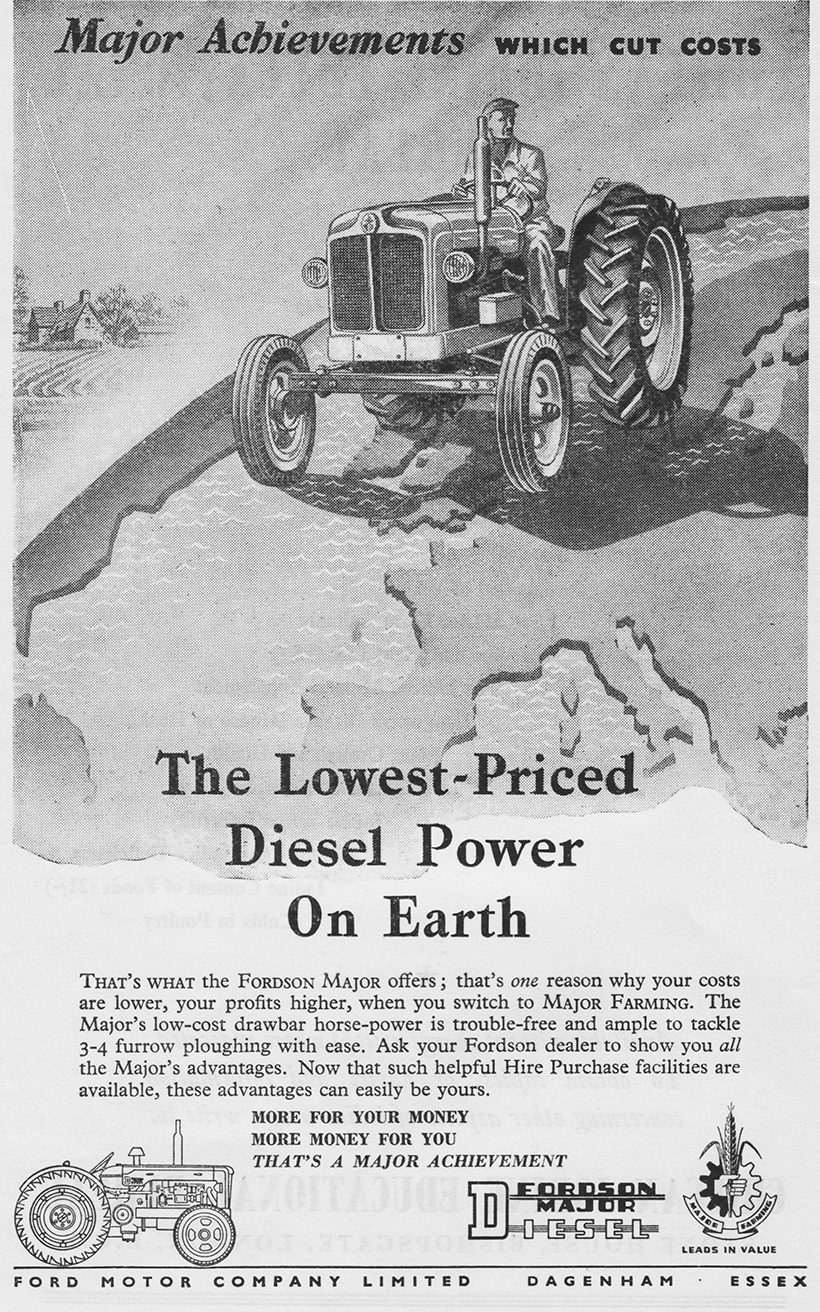
By 1954, diesel was becoming the fuel of choice for farmers, however, with just 40hp or thereabouts on tap from the early E1A’s engine, Ford was in danger of being left behind in the power race.
Other tractor manufacturers were developing 50hp diesel engines by the mid-1950s, and so Ford needed to be doing the same, particularly as it launched the Thames Trader Lorry in May 1957 which, as well as a six-cylinder engine, offered a ‘4d’ Livedrive-Live PTO engine with a modified manifold, giving maximum revs of 1,800rpm.
Ford’s answer was the Fordson Power Major, which was distinguished by its three-spoke wheels, and was produced from July 1958 with the uprated, 51hp MkII engine.
MKII engine developments
The MkII engine underwent more extensive changes, including in-line ports for the manifolds, a throttle linkage change plus modifications to the rocker shafts and cover. As the diesel engine developed, power output increased to over 50hp, and it gained a reputation for reliability; eventually, 98% of all E1A production was diesel-powered.
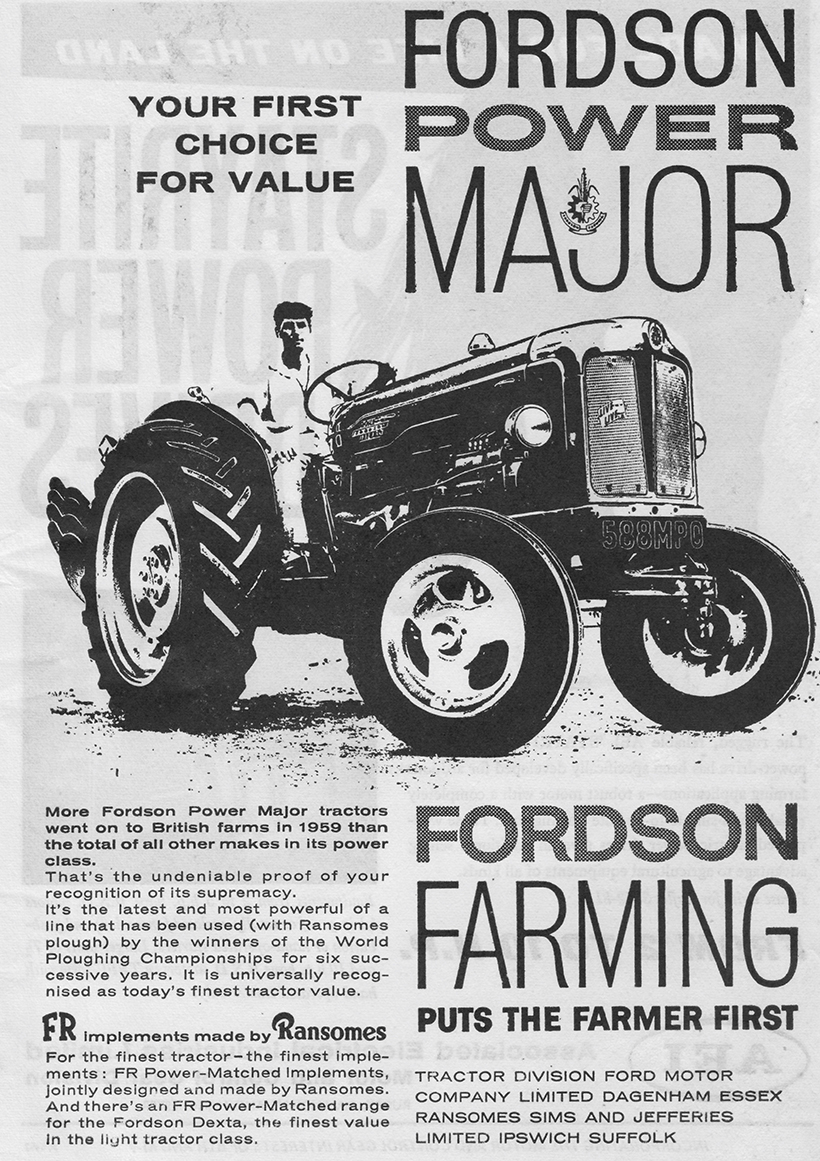
The Power Major had a lifespan of just two years, but was the first Fordson tractor to break the 50hp barrier. Its new, improved engine – rated at 51.8hp at 1,600rpm – used shorter, ‘right-handed’ rocker arms than were found on the earlier, MkII engine, and reverted to the injectors used in the Mk I engine (nozzle No.N123). Injection timing was 23° BTDC.
The final Power Major was introduced on the 21st November, 1960. Production of the Fordson Super Major started at No.1575971, although it was introduced at tractor number 1578886, so there’s some overlapping of serial numbers.
The Super Major had its headlights fitted within the front grill, unlike previous models which had them on the sides of the radiator cowl. Super Majors were also equipped with the Qualitrol position control and flow-control hydraulic system. A new system of numbering was introduced from November 1961, starting at 08A-300001-M
The 55hp, New Performance Super Major was introduced in July 1963 (08C-960337-F), with a new colour scheme of New Performance Super Major blue matched with grey-painted, pressed-steel wheels and mudguards.

The New Performance Super Major was the last tractor to bear the Fordson name, and the final model to be produced at Ford’s Dagenham factory.
Castings were stamped ‘FL’ instead of ‘ENFO’ on earlier models. The Simms fuel pump was also upgraded to a Minimec fuel injection pump, and Dagenham-made US models were sold as the Ford 5000 Super Major, and featured a grey bonnet.
Many conversions
County Commercial Cars had already produced a crawler based on the E27N, and carried on producing both agricultural and industrial crawlers. In addition, the Fleet-based company also produced the equal-wheeled County Super Four, based on the Super Major. Roadless manufactured both full- and half-track models, with Selene transfer gearboxes and front axles being used to produce Manual-Roadless 4WD models, culminating in the six-cylinder, Roadless 6/4 Ploughmaster conversion.
Narrow versions for orchard use were produced by KFD (Kent Ford Dealers), and E1A skid units were to provide the basis for Chase-Side, Muir-Hill, Whitlock, Bray. Perhaps most notably, though, E1A skid units were supplied to JC Bamford (JCB), where the Dinkum Digger – equipped with a backhoe – was created, giving birth to the famous earthmoving empire.

A Power Major and Super Major from Jane and Stephen Brooks’ private collection; note the side-mounted lights on the Power Major (left), compared to those fitted within the grill panels on the Super Major.
The Power Major was also used to make the first, commercially available, dual-drive tractor; the Ernest Doe of Essex ‘Doe Dual Power’.
The New Performance Super Major was the last tractor to bear the ‘Fordson’ name, and the final tractor to be produced at Dagenham. The next in line – the 1000 Series range of tractors – were built at Basildon.
The E27N, and E1A range of Diesel, Power and Super Majors were only ever built at Dagenham but, sometimes the casting codes got a bit muddled up when earlier components were put on later tractors, and some letters were missed out of the date sequences.

One of several conversions of the E1A series; a Doe Dual Drive based on an early Super Major (circa 1960).
Casting codes
The casting codes can be somewhat muddling for the EIA models. They consisted of a month letter, a date number and a year letter, until June 1963, when they reversed the order, with the year letter appearing first. Then, to add to the confusion, earlier components were sometimes put on to later tractors, and sources of information for the sequence of letters and numbers can be contradictory.
These are the most up to date codes: 1951 is ‘S’, 1952 is ‘T’ followed by ‘U’, ‘V’, ‘X’, ‘Z’, and then ‘A’ in 1957, through to ‘J’ for 1963, missing out the letters ‘E’ and ‘G’ from the sequence. Additionally, in 1963, the number ‘3’ was used to represent that year and, likewise, ‘4’ was adopted in 1964.
Month letters remained the same as for the E27N until 1963, when the sequence changed to ‘A’ for January, through to ‘N’ for December. Another complication is that the EIA Major tooling was sold to the Spanish manufacturer, Ebro, in 1965, which went on to manufacture the New Performance Super Major-based Ebro Super 55 and 160E models. So, some tractors can be found with these parts, or with a Spanish-built engine.
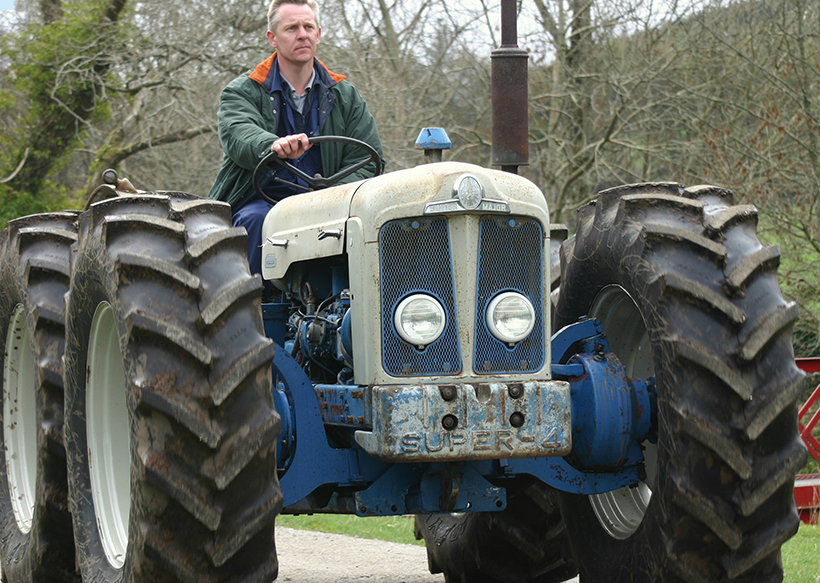
County Commercial Cars produced the equal-wheeled County Super Four, a machine that was also based on the Super Major.
New Fordson Major production – Dagenham
1951 1217101 to 1217103
1952 1217104 to 1247380
1953 1247381 to 1276856
1954 1276857 to 1322524
1955 1322525 to 1371417
1956 1371418 to 1412408
1957 1412409 to 1458380
1958 1458381 to 1481013
Fordson Power Major production – Dagenham
1958 1481091 to 1494457
1959 1494458 to 1538064
1960 1538065 to 1578885
Fordson Super Major production – Dagenham
1960 1578886 to 1583905
1961 1583906 to 1619437
1961 08A-300001-M to 08A-302578-N
1962 08B-741001-A to 08B-778355-N
1963 08C-781470-A to 08C-960336-F
New Performance Super Major production – Dagenham
1963 08C-960337-F to 08C-982803-N
1964 08D-940000-A to 08D-976148-L
For a money-saving subscription to Ford & Fordson Tractors magazine, simply click here




